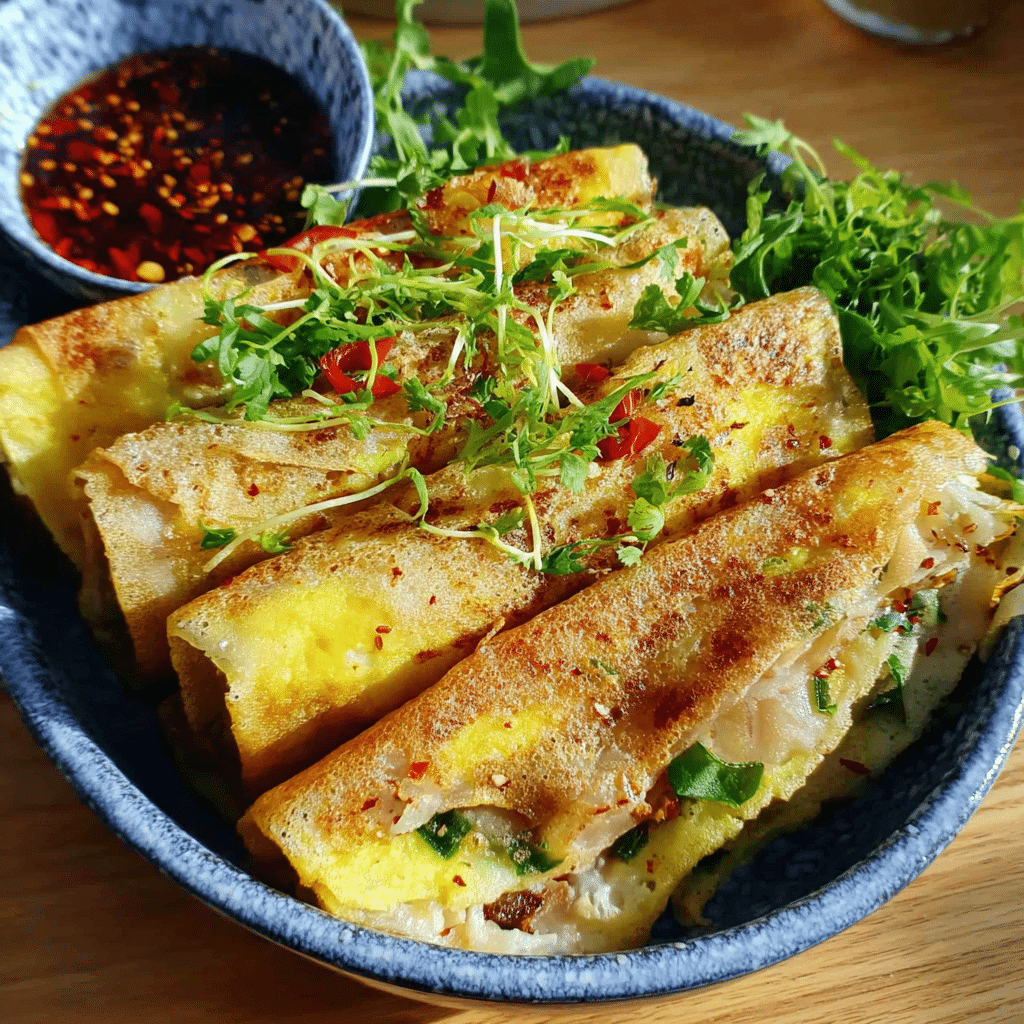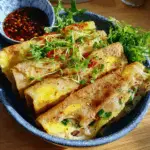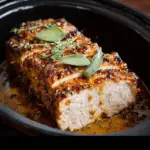The iconic Chinese street food, Jian Bing, is a flavorful and crispy crepe traditionally served hot and fresh from roadside vendors. It’s an irresistible fusion of textures—soft crepe, creamy egg, fresh herbs, and a signature crackling crunch from fried crackers—all bound together with hoisin and chili sauces.
This version brings all the magic of Chinese mornings into your kitchen with easy-to-find ingredients and simple techniques. Whether you’re craving a unique brunch idea or need a satisfying savory snack, Jian Bing delivers every time. Plus, it’s customizable: spicy, mild, vegetarian—make it yours and enjoy a bite of authentic Beijing from your stovetop.
Full Recipe
Ingredients:
-
1/2 cup all-purpose flour
-
1/4 cup mung bean flour (or use more all-purpose if unavailable)
-
1/2 tsp salt
-
1 cup water
-
2 large eggs
-
2 tablespoons vegetable oil
-
2 tbsp hoisin sauce
-
1 tbsp chili oil or chili sauce (optional)
-
2 scallions, finely chopped
-
Fresh cilantro, chopped (optional)
-
Crispy wonton wrappers or Chinese fried crackers (baocui)
-
Lettuce leaves (optional, for extra crunch)
Directions:
-
In a bowl, mix the flours and salt, then gradually add water while whisking until smooth and lump-free. Let the batter rest for 10 minutes.
-
Heat a non-stick skillet or crepe pan over medium heat and brush with a thin layer of oil.
-
Pour a ladle of the batter onto the pan and quickly spread it into a thin circle using the back of the ladle.
-
Crack an egg over the crepe and spread it evenly with a spatula. Sprinkle chopped scallions and cilantro (if using) over the egg.
-
When the bottom is golden and crispy and the egg is mostly cooked, flip the crepe over carefully.
-
Brush the top with hoisin sauce and chili oil to taste.
-
Place crispy crackers and a few lettuce leaves in the center of the crepe.
-
Fold the sides inward and roll it up into a square or rectangle. Remove from heat and serve hot!
Prep Time: 10 minutes | Cooking Time: 10 minutes | Total Time: 20 minutes
Kcal: 260 kcal | Servings: 2 servings
What Is Jian Bing?
Jian Bing (煎饼), often referred to as the Chinese savory crepe, is one of China’s most beloved street foods, particularly popular in northern cities like Beijing and Tianjin. This humble but highly flavorful breakfast item is made fresh to order on large round griddles. It’s known for its crispy yet chewy texture, a perfectly fried egg, bold sauces, fresh herbs, and an addictive crunch from fried crackers or “baocui” (薄脆).
While it originated centuries ago—some historians trace it back to the Shandong province during the Three Kingdoms period—Jian Bing continues to evolve, adapting to modern kitchens and diets. The core concept, however, remains the same: a comforting, handheld meal packed with contrasting textures and flavors.
Cultural Significance and Origins
Jian Bing is more than just food—it’s a ritual for millions of Chinese people. Early mornings in China often begin with the aroma of sizzling batter, the rhythm of ladles spreading crepe dough, and the pop of eggs hitting hot surfaces. Whether you’re a student rushing to class, a worker on the morning commute, or a local craving a fast, hearty breakfast, Jian Bing has been a cultural staple for generations.
Its roots in Shandong and Tianjin are particularly strong. While it was once a rural dish, modern urbanization brought Jian Bing to city streets where it quickly gained popularity. Street vendors have elevated the art of making Jian Bing, with each vendor having their unique recipe or technique passed down through family lines.
A Symphony of Textures and Flavors
What makes Jian Bing truly special is its combination of textures. The base is a thin crepe made from wheat flour and often mung bean flour, lending a slight nuttiness and elasticity. As the crepe cooks, an egg is cracked and spread across the surface, then topped with chopped scallions, cilantro, and sometimes sesame seeds for added aroma and flavor.
The sauces—typically hoisin for sweetness and fermented bean paste or chili oil for depth and heat—are spread generously. The real magic comes with the addition of the crispy element: fried crackers, often homemade or store-bought wonton wrappers, provide a satisfying snap with each bite.
The result is a harmonious balance of soft, crisp, savory, spicy, and fresh. It’s a dish that engages the senses and satisfies in a way that few breakfast items can.
Regional and Modern Variations
Like many traditional foods, Jian Bing has seen various regional adaptations. In Tianjin, for example, you might find a thinner batter and more intense garlic flavor in the sauces. In other areas, pickled vegetables or tofu skin are added. Shanghai versions tend to be a bit sweeter, while the Beijing-style is known for its extra crispy texture.
Outside of China, Jian Bing has gained international attention in food trucks, modern Chinese cafes, and fusion brunch menus. Some versions replace the traditional cracker with bacon or fried chicken for a more Western twist. Vegetarian or even vegan versions swap the egg for tofu scramble, and some recipes use gluten-free flours to cater to dietary restrictions.
This adaptability is a testament to how globally appreciated Jian Bing has become. It’s now served in major cities like New York, San Francisco, London, and Sydney, often with innovative flair while preserving its street food soul.
Why Jian Bing Stands Out
At its heart, Jian Bing is a reflection of everything that makes Chinese cuisine so loved worldwide: balance, texture, contrast, and boldness. It’s fast food in the best sense—made to order, cooked with skill, and endlessly satisfying.
One of the reasons Jian Bing stands out in the crowded world of breakfast foods is its versatility. It can be a light vegetarian wrap or a hearty, protein-packed roll. The sauces can be spicy or mild, sweet or tangy. You can add pickled vegetables, extra herbs, even cheese or kimchi, depending on your flavor preferences. And the visual appeal—the golden crepe, vibrant green herbs, glistening sauces, and the deep crunch of crackers—makes it a hit not only on the plate but on social media feeds around the world.
How to Serve Jian Bing at Home
Although originally a street food, Jian Bing is surprisingly achievable in a home kitchen. A non-stick skillet or crepe pan, a simple batter, and a few pantry staples are all it takes to recreate the magic. Homemade versions let you tailor everything to your taste—from the spice level of the chili sauce to the choice of crispy element (wonton wrappers, tortilla chips, rice crackers, etc.).
It’s best served hot off the skillet, eaten right away while the inside is steamy and the cracker is still crunchy. You can enjoy it as a breakfast wrap, a savory lunch, or even a late-night snack. For a balanced meal, pair it with hot soy milk or a lightly brewed Chinese tea.
Tips for Making Perfect Jian Bing
-
Rest the Batter: Letting the batter sit for 10-15 minutes helps hydrate the flour and creates a smoother texture.
-
Use High Heat: The crepe should cook quickly so it becomes slightly crisp around the edges.
-
Spread the Egg Evenly: This ensures each bite has that lovely egg flavor and texture.
-
Don’t Overfill: Too many fillings make it hard to fold and diminish the texture contrast.
-
Serve Immediately: The longer it sits, the softer the cracker becomes. Timing is everything!
Pairing Ideas and Serving Suggestions
Traditionally, Jian Bing is consumed on its own, but it also works well with light sides or beverages. Pair it with:
-
A cup of warm soy milk
-
Lightly pickled radishes or cucumbers
-
Hot jasmine or pu-erh tea
-
A fresh fruit smoothie for fusion flair
-
A bowl of congee for a more filling breakfast spread
For parties or brunches, cut the Jian Bing into quarters and serve as finger food with dipping sauces like sesame dressing or sweet chili.
Nutritional Insights
Jian Bing can be fairly nutritious, especially when made with mung bean flour, which adds protein and fiber. The egg contributes healthy fats and more protein, while herbs offer antioxidants and flavor with minimal calories. Of course, calories can climb depending on sauce quantity and fried cracker content, but it’s easy to control portions when making it at home.
By adjusting the batter or fillings—using gluten-free flours, air-frying the crispy elements, or adding more vegetables—you can make it fit a variety of dietary preferences.
Conclusion: Why Jian Bing Deserves a Spot on Your Table
Jian Bing is not just a meal—it’s an experience. Its origins are rooted in tradition, but its flavors speak to modern palates. Whether you’re craving something new for brunch, exploring global cuisines, or simply want a satisfying bite with real texture, Jian Bing offers it all.
This dish brings people together, whether on busy Chinese streets or around your home kitchen table. It’s a testament to how food can bridge cultures, offer comfort, and spark joy. If you haven’t tried Jian Bing yet, now’s the perfect time. And once you do, don’t be surprised if it becomes a go-to in your breakfast or lunch rotation.
From its sizzling start on the griddle to that first crunch and rich umami flavor—Jian Bing is proof that some of the best meals are the ones you can hold in your hands.






